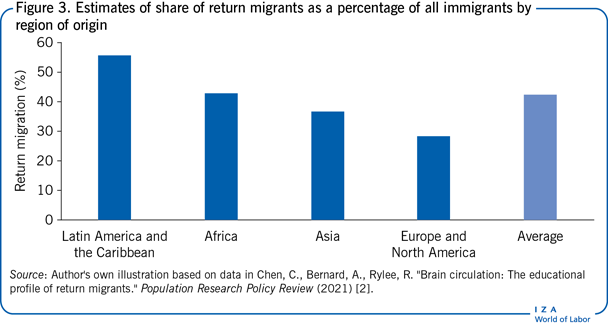Elevator pitch
Return migration can have multiple benefits. It allows migrants who have accumulated savings abroad to ease credit constraints at home and set up a business. Also, emigrants from low- and middle-income countries who have invested in their human capital may earn higher wages when they return. However, whether the home country benefits from return migrants depends on the migrant's success in accumulating savings and human capital and on the home country's ability to make use of returnees’ skills and investment. To benefit from returnees, home countries need policies that encourage returnees’ investment and labor market reintegration.
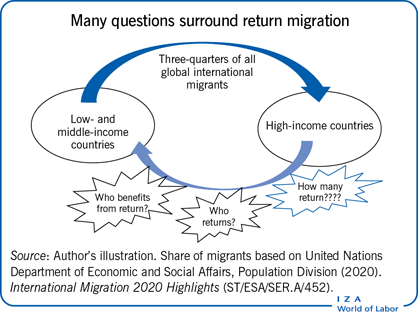
Key findings
Pros
On average an estimated two migrants in five will leave the host country within five years of arrival.
Migrants accumulate savings, which increases their probability of setting up a business when they return to their home country.
Migrants acquire skills abroad that allow them to earn higher wages than non-migrants when they return.
Return migrants transfer new ideas and norms that can improve economic and political outcomes in their home country.
Return migration can be beneficial to the economic development of the home country.
Cons
Bureaucracy and red tape can impede returnees’ efforts to invest after they return.
Skills acquired abroad do not always match the skills needed in the home labor market.
Home country institutions might not be receptive to new ideas and norms acquired by migrants abroad.
Not all migrants who return home will have been successful abroad.
Data on return migration are sparse and inconsistent, making analysis difficult.
Author's main message
Return migration has many potential benefits. Through employment abroad, migrants can increase their income, acquire new skills, and accumulate savings and assets. When migrants return, they transfer both the financial and human capital accumulated abroad. However, benefits materialize in the home country only if return migrants are successful overseas in gaining skills, knowledge, and savings and if the home country has the right policies to encourage investment by returnees and to use their skills. Policy options include reducing red tape, providing information on investment possibilities, and establishing a favorable macroeconomic environment for investment.
Motivation
Many people think of international migration as a one-way move. In reality, many immigrants move only temporarily. Migration is dynamic. There is increasing evidence of frequent return migration.
Global migration has continued to rise over the past five decades. Between 1960 and 2020, the global migrant stock increased from 92 million to 281 million people, with much of the increase driven by migrants moving from middle-income countries to high-income countries. However, those flows are not always permanent moves as many migrants return to their country of origin after a period of overseas stay.
Return migration is at the heart of the debate on the costs and benefits of international migration. Estimates by the OECD suggest that on average about two migrants in five will leave the host country within five years of their arrival, often transferring savings and new education and skills gained abroad. There is a huge variation in return rates by country of destination and country of origin. Yet an important and understudied issue is whether return migration contributes to the economic development of the home country. Who benefits from return to low- and middle-income countries?
Discussion of pros and cons
Emigration from low- and middle-income countries
In 2020, high-income countries hosted 65% of all international migrants globally, while middle-income destinations, mostly high-middle-income, had 31% of the global migrant stock. Figure 1 shows the number of international migrants by region of origin and destination, and income group. The number of emigrants varies considerably among sending low- and middle-income countries. Yet, the top ten origin countries account for almost one-third of all emigrants globally. India tops the list of migrant-sending countries, with 18 million emigrants in 2020, followed by Mexico, at 12 million, and China, at 10 million. Half of all international migrants live in Europe and North America. A few receiving high-income countries host a significant number of world migrants. In 2020, the top ten countries of destination hosted about half of all international migrants, with 51 million immigrants in the US, 16 million in Germany, and 13 million in Saudi Arabia [1].
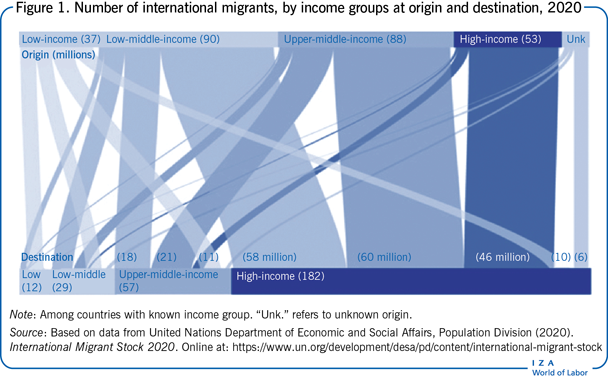
Out-migration and return migration
There is increasing evidence of frequent return migration. Although most countries record immigration inflows, few record outflows. According to the OECD, 20–50% of immigrants leave within five years of arrival, either to return home or to move to a third country. Figure 2, which shows outflows in a few European countries where immigration is predominately from lower-income countries, makes clear that outflows are far from negligible. And since the stock of the foreign-born population in those countries is much greater than recent inflows, outflows tend to be relatively smaller compared with stocks of the foreign-born population, but not negligible.
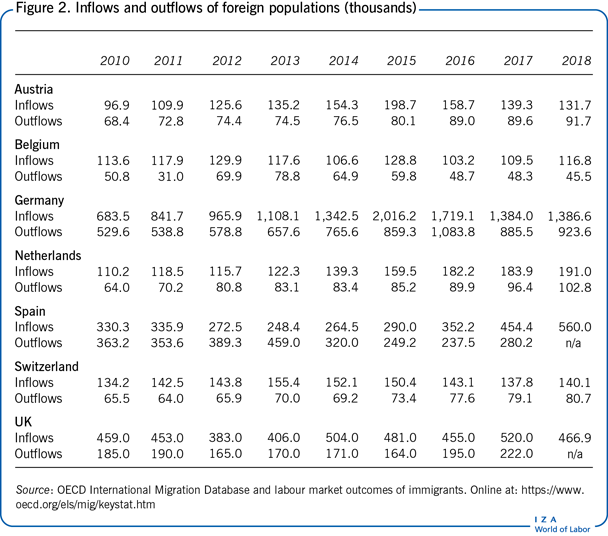
The small amount of evidence available on out-migration suggests that most of it is return migration to the country of origin. For example, onward migration constituted less than one-third of total out-migration in Sweden.
Return migration—temporary overseas migration followed by a return to the country of origin—includes not only migrants on a temporary visa (such as workers on work permits and students), but also migrants on permanent visas who decide to return home after spending time abroad. Statistics on the numbers of return migrants are not well recorded, as governments do not regularly collect data on migrant outflows. Administrative records are often used instead. A few countries have population registers that can help keep track of who is in the country and who has left, but few registers have systemic procedures for de-registering immigrants leaving the country. Another obvious problem is that out-migration does not necessarily mean return migration to the home country.
Numbers of return migrants can also be derived from source country data. For example, the 2010 Mexican Census documents return migration of 31% for Mexicans who had moved to the US between 2005 and 2010. In contrast, the Moroccan Census in 2004 shows 165,416 return migrants during 1999–2003, or only a 5% return rate. Thus, the return rate to developing countries of origin varies immensely by country of origin and destination. Estimates for the Philippines, which has a high proportion of emigrants on temporary contracts, suggest that there are around 3.5–4.5 million returnees in the country.
The challenge for source countries in measuring return migration is that they need to collect data on all their emigrants—current and returnees—in order to be able to measure the rate of return. Indeed, recent estimates based on census data for a sample of 60 countries suggest that return migrants constitute a large share of immigrants, around 42% on average, though Latin America and the Caribbean (56%) and Africa (43%) have higher return rates compared to Asia (37%) and Europe and North America (28%) as shown in Figure 3 [2].
Why do migrants return?
Why do migrants return to a poorer country, where wages are lower than in the host destination? There are several reasons other than failure in the host country. In many cases, migrants prefer to live and work where their families are. In many cases, the return decision is part of a migration strategy to move temporarily to accumulate savings and acquire skills and knowledge to use in their home country [3]. Some want to accumulate savings abroad to use in the home country, where the savings will have higher purchasing power. Some plan to use their savings to set up a business when they return because of the higher rate of return on entrepreneurial activities in the home country [4], [5]. Also, people may migrate temporarily to acquire skills that are highly rewarded in the home country. For example, overseas migration might increase the migrant's productivity only slightly in the host country, but the productivity may be important and highly valued in the home country.
Of course, not all returns are planned. Migrants might decide to return because the expected value of lifetime income is lower in the host country than in the home country [6]. Migrants might not be as successful as anticipated and might thus return if they are unable to meet their target savings or skills acquisition, perhaps because they become unemployed or because of the high cost of living in the host country. Personal, family, or political crises can also drive migrants to return.
Who returns?
Who returns matters for both the host and the home country. First, the characteristics of returnees, in particular their education levels, affect their probability of return as well as their contribution to their home country after their return. Return rates are generally high for highly educated migrants, such as students who return after their studies abroad. The empirical evidence on return at different education levels is specific to host and home country. For example, for Spain, the re-emigration rate of highly skilled immigrants is above average, while for the US, immigrants with a low education and those with a higher education have a much higher re-emigration rate than immigrants with an intermediate level of education (Figure 4).
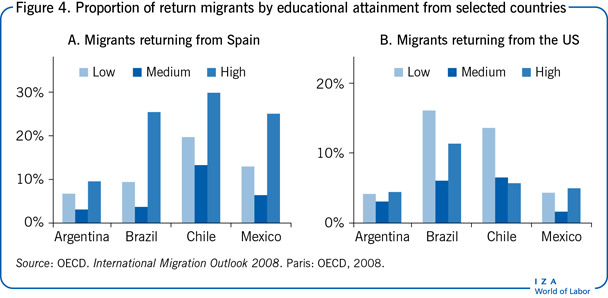
In addition, return is influenced by the success of immigrants in the host country. A few empirical studies have focused on the relationship between immigrant earnings and return, where earnings are used as a measure of success. Evidence for the Netherlands suggests a U-shaped relationship, with both low- and high-income immigrants leaving the country but with the low-income immigrants leaving faster [7]. This pattern supports the empirical evidence that unemployment pushes immigrants to leave the host country. Thus, unsuccessful immigrants are more likely to leave the host country than the average immigrant and are also more likely to return early in the migration cycle because of failure. Successful immigrants are also more likely to leave than the average immigrant, but they leave because they have achieved their target savings.
Who benefits from return migration and how?
Emigration and return migration decisions are individual/household decisions in which individuals weigh the benefits and costs and embark on long emigration journeys when the benefits outweigh the costs. Emigration and return migration also lead to substantial externalities for the home country through investment, remittances, increased productivity, and skills transfers by return migrants. However, if returnees are not able to reintegrate into the home labor market after a period of absence, or if they return with skills that do not match the requirements of the home labor market, this could lead to brain waste rather than brain gain. Also, if returnees are not encouraged to invest and use their savings in economic enterprises in the home country, their capital might not be used to greatest advantage. There are also externalities for the host country, with benefits or losses dependent on the selectivity of returnees (whether successful or unsuccessful migrants tend to return).
Investment and the home country
In many poor developing countries, lack of access to credit is a severe constraint to entrepreneurship. Emigration enables credit-constrained individuals to acquire savings to set up businesses once they return [4], [5]. This is an important channel through which returnees contribute to investment and economic development in the home country. In particular, when unemployment in the home country is high, small- and medium-size enterprises can provide jobs and reduce poverty, making entrepreneurship an engine of growth.
Several studies find evidence for many developing and emerging market countries that return migrants are more likely than non-migrants to set up businesses. Earlier studies focus on how credit constraints and savings to overcome them increase the probability of returnees becoming entrepreneurs. In some instances, return migrants have made significant contributions. For example, in 2007 return migrants accounted for one-third of the start-ups in Taiwan's Hsinchu Science-based Industrial Park and accounted for 10% of exports. Half of the leading software firms in India in 2000 were founded by Indian return migrants from the US. Although returnees show a high ability to create small- and medium-size businesses and to generate jobs, return migrants face many hurdles when setting up their businesses, not least the many administrative and institutional barriers common in developing countries.
Remittances and the home country
Remittances are an important source of foreign currency for many developing countries and the most tangible link between migration and development. India, China, Mexico, and the Philippines are the largest recipients of official recorded migrant remittances—not surprising, given the size of their emigrant population. Remittances amount to a large share of GDP for some smaller developing countries, such as Lesotho, Liberia, Moldova, and Tajikistan.
Migrants planning to return to their home country maintain ties with the home country and send back remittances while they are abroad. Remittances enable family members left behind to improve their living standards and sometimes to escape poverty. As such, there are potential costs associated with return migration. The financial flows that arrive while the migrant is abroad cease once the migrant returns home. While return migrants might repatriate all their savings when they return, benefiting the home country, the source of flow ceases.
Higher wages and productivity of the returnee and the home country
Return migrants can be an important source of growth for the home country through their accumulated knowledge and skills. Student migrants who return after studying abroad are an example. According to the OECD, there were more than four million foreign students in OECD countries in 2011. More than half of them originated in Asia; China and India were the top two countries of origin for foreign students.
In addition to students, migrant workers also accumulate human capital by acquiring skills abroad that allow them to earn a wage premium compared with non-migrants when they return home [8], [9]. A few studies have examined the impact of experience abroad on the human capital accumulation of return workers. One focus has been to measure the “returns to returning” by examining the wage premium of return migrants compared to non-migrants and taking into account the non-random nature of who migrates and who returns. Overall, the empirical findings show that migrants from developing countries benefit. For example, Mexicans who migrate to the US and then return reap a wage premium compared with those who do not migrate [8]. Returnees in West Africa experience a substantial wage premium, but only for migrants returning from an OECD country. Similarly, Egyptian return migrants earn on average 16% more than non-migrants, but highly educated return migrants benefit more than less educated returnees [9]. University graduate returnees earn 24% more than non-migrants, while less educated returnees earn 10% more.
Another aspect of the skill enhancement of temporary migrants is measured through the occupational mobility of returnees. In Albania, migration experience increases the likelihood of upward occupational mobility of returnees compared with non-migrants, and the impacts on occupational mobility differ by type of work and country of migration. The impact of skill acquisition on occupational mobility seems to depend on the migrant's education level, with highly educated returnees likely to benefit more from the skills they acquired abroad than are unskilled returnees.
Whether the migrant and the home country benefit from return migration also depends on whether the return migrant is able to use the experience gained abroad in the home labor market. Age is one determinant of whether a returnee participates in the labor market or not. The return of a retiree, for example, is likely to be associated with no contribution to productive capacity if he or she does not participate in the labor market compared with the return of a working-age individual.
Whether migrants who acquire human capital overseas have higher salaries than non-migrants when they return and join the labor market depends to some extent on the country of emigration and the level of education of the migrant. The reintegration of returnees into the home labor market is not always straightforward. There might be an adjustment cost as returnees get used to the home labor market again. There may be delays to participation in the home labor market if returnees bring skills that do not match the requirements of the home labor market, or if they have higher reservation wages when they return. In some cases, over-qualification can be a problem.
Ideas and norm transfer and the home country
Migration and the return of migrants to their home country also result in the transmission of knowledge, ideas, and social norms, which may benefit the home country [10]. When migrants move to another country, they are exposed to different cultures, social norms, and political ideologies. Return migrants can transmit to their home country ideas about the quality of political institutions, raising awareness and demand for political accountability and increasing direct participation in the political system. For example, a seminal study based on a comprehensive panel data set of foreign students worldwide over 50 years finds that foreign-educated returnees bring about democratic change at home if they acquire their education in a democratic country [11]. In 2006, 45 heads of government had studied at US universities. Also, emigration positively affects demand for political accountability, in particular when migrants return from countries with better governance [12]. Return migrants have a stronger impact than migrants still abroad because returnees can directly influence their networks in the home country. Moreover, return migrants can affect political outcomes in the home country by participating in elections. However, the host country matters: migrating to less democratic countries can have a negative influence on the behavior and attitude of returnees [11], [12].
Migration also exposes migrants to new social norms [10]. International migration results in a transfer of behavioral norms such as those related to fertility from host to home country. A few studies find that returnees adjust their fertility choices to the norms that prevail in the country to which they had emigrated. However, the empirical evidence suggests that the transferred norms are not always favorable or beneficial to the country of origin, as returnees might also transfer a preference for higher fertility rates [13] or more traditional gender roles [14].
Does the host country gain or lose?
Whether the host country benefits from return migration depends to a large extent on the selectivity of returnees. If unsuccessful migrants leave, the host country would experience positive fiscal gains since unsuccessful migrants (e.g. those who are unemployed or underemployed) tend to be a burden on the fiscal system in the host country. But if successful migrants leave, this might lead to fiscal loss for the host country because successful migrants tend to contribute to productivity, growth, and government revenue.
There is empirical evidence that return migration tends to accentuate the selection that originally motivated the immigrant flow. Return migration selection tends to be the reverse of the initial selection process. If the host country attracts mainly skilled migrants, the return migrants will likely be less skilled on average than the remaining immigrants in the host country. Alternatively, if the host country attracts relatively unskilled workers, it will be the better skilled among them who are most likely to return [6].
Limitations and gaps
Although there are multiple potential channels through which return migration can influence the economic development of the home country, there are several challenges that limit understanding the real impact of return migration. The biggest hurdle is the lack of data on return migration, which curtails macroeconomic assessment of the effect of return migration on the home country. The main challenge in assessing the impact of return migration is the non-randomness of return migration. Data limitations have been a major constraint in allowing unbiased measures of the impact of return migration on the home economy. Another challenge is that almost all studies on the impact of return migration examine the individual and the micro level but not the impact on the aggregate macro-economy.
Summary and policy advice
There is no doubt that return migration is an important phenomenon. Yet there is a gap in knowledge of the exact size of return migration and of who returns and who does not. Both home and host countries need to collect better data on return migration to expand knowledge of its impacts.
The contribution of migrants to the development of their home country results from a combination of the human, financial, and social capital they transfer while abroad and when they return, and of the returns to those resources. Individual migrants benefit from return migration, as they tend to do better when they return than non-migrants. Home countries benefit from return migration when it leads to higher investment and productivity by returnees. However, the benefits will differ from one developing country to another and even from one sector or region to another within the same country.
The right mix of policies is required to maximize the benefits of return migration by the home country. To support return migrants in starting a business that can contribute to job creation, governments can reduce red tape, offer financial incentives such as tax holidays, and provide information on investment possibilities. Establishing the right macroeconomic environment is also essential to encourage investment. Furthermore, investors need assurances that their rights will be protected and that contracts will be enforced. Finally, lowering the cost of sending back money should be high on the global political agenda to boost remittances to poor developing countries.
Acknowledgments
The author thanks an anonymous referee and the IZA World of Labor editors for many helpful suggestions on earlier drafts. Financial support from the Economic and Social Research Council [RES-167-25-0678] is gratefully acknowledged. Version 2 of the article updates existing figures and adds a new Figure 3, includes a new “Further reading reference,” and adds new “Key references” [1], [2], [10], [14].
Competing interests
The IZA World of Labor project is committed to the IZA Code of Conduct. The author declares to have observed the principles outlined in the code.
© Jackline Wahba
